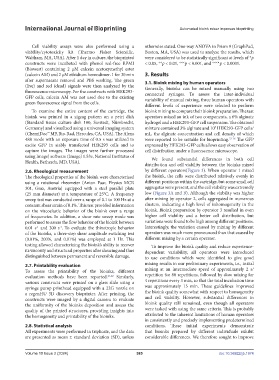Page 393 - IJB-10-2
P. 393
International Journal of Bioprinting Automated bioink mixer improves bioprinting
Cell viability assays were also performed using a otherwise stated. One-way ANOVA in Prism 9 (GraphPad,
viability/cytotoxicity kit (Thermo Fisher Scientific, Boston, MA, USA) was used to analyze the results, which
Waltham, MA, USA). After 1 day in culture, the bioprinted were considered to be statistically significant at levels of *p
constructs were incubated with phenol red-free RPMI < 0.05, **p < 0.01, ***p < 0.001, and ****p < 0.0001.
(Biowest) containing 2 µM calcein acetoxymethyl ester
(calcein AM) and 2 µM ethidium homodimer-1 for 30 min 3. Results
after supernatant removal and PBS washing. The green 3.1. Bioink mixing by human operators
(live) and red (dead) signals were then analyzed by the Generally, bioinks can be mixed manually using two
fluorescence microscopy. For the constructs with HEK293- connected syringes. To assess the inter-individual
GFP cells, calcein AM was not used due to the existing variability of manual mixing, three human operators with
green fluorescence signal from the cells. different levels of experience were selected to perform
To examine the entire content of the cartridge, the bioink mixing to compare their bioink preparation. The test
bioink was printed in a zigzag pattern on a petri dish operators mixed an ink of two components, a 6% alginate
(Standard tissue culture dish 100; Sarstedt, Nümbrecht, hydrogel and a HEK293-GFP cell suspension. The obtained
Germany) and visualized using a universal imaging system mixture contained 3% alginate and 10 HEK293-GFP cells/
7
(ChemiDoc™ MP, Bio-Rad, Hercules, CA, USA). The Alexa mL, the alginate concentration and cell density of which
488 mode with an exposure time of 0.5 s was utilized to were reported to be suitable for bioprinting. 23-26 The GFP
excite GFP in stably transfected HEK293 cells and to expressed by HEK293-GFP cells allows easy observation of
capture the images. The images were further processed cell distribution under a fluorescence microscope.
using ImageJ software (ImageJ 1.53e, National Institutes of We found substantial differences in both cell
Health, Bethesda, MD, USA).
distribution and cell viability between the bioinks mixed
2.6. Rheological measurement by different operators(Figure 3). When operator 1 mixed
The rheological properties of the bioink were characterized the bioink, the cells were distributed relatively evenly in
using a rotational rheometer (Anton Paar, Physics MCR different positions within the cartridge, but some small cell
301, Graz, Austria) equipped with a steel parallel plate aggregates were present, and the cell viability was extremely
(25 mm diameter) at a temperature of 25°C. A frequency low (Figure 3A and B). Although the viability was higher
sweep test was conducted over a range of 0.1 to 100 Hz at a after mixing by operator 2, cells aggregated in numerous
constant shear strain of 0.1%. This test provided information clusters, indicating a high level of inhomogeneity in the
on the viscoelastic behavior of the bioink over a range bioink. Bioink preparation by operator 3 resulted in even
of frequencies. In addition, a shear rate sweep mode was higher cell viability and a better cell distribution, but
performed to assess the flow behavior of the bioink between variations were found to be high among different positions.
-1
0.01 s and 300 s . To evaluate the thixotropic behavior Interestingly, the variation caused by mixing by different
-1
of the bioinks, a three-step shear amplitude switching test operators was much more pronounced than that caused by
(0.01%, 200%, and 0.01%) was employed at 1 Hz. This different mixing by a certain operator.
testing allowed characterizing the bioink’s ability to recover To improve the bioink quality and reduce experience-
its viscosity and structural properties after shearing and thus dependent variability, all operators were introduced
distinguished between permanent and reversible damage. to use conditions which were identified to give good
2.7. Printability evaluation mixing results in our preliminary experiments, i.e., initial
To assess the printability of the bioinks, different mixing at an intermediate speed of approximately 2 s/
evaluation methods have been reported. 21,22 Similarly, repetition for 80 repetitions, followed by slow mixing for
various constructs were printed on a glass slide using a 4 repetitions every 3 min, so that the total incubation time
syringe pump printhead equipped with a 22G nozzle on was approximately 15 min. These guidelines improved
a regenHU 3D discovery bioprinter. After printing, the the bioink quality somewhat with respect to homogeneity
constructs were imaged by a digital camera to evaluate and cell viability. However, substantial differences in
the uniformity of the bioinks deposition and assess the bioink quality still remained, even though all operators
quality of the printed structures, providing insights into were tasked with using the same criteria. This is probably
the homogeneity and printability of the bioinks. attributed to the inherent limitations of human operators
in consistently and precisely implementing predetermined
2.8. Statistical analysis conditions. These initial experiments demonstrate
All experiments were performed in triplicate, and the data that bioinks prepared by different individuals exhibit
are presented as mean ± standard deviation (SD), unless considerable differences. We therefore sought to improve
Volume 10 Issue 2 (2024) 385 doi: 10.36922/ijb.1974

